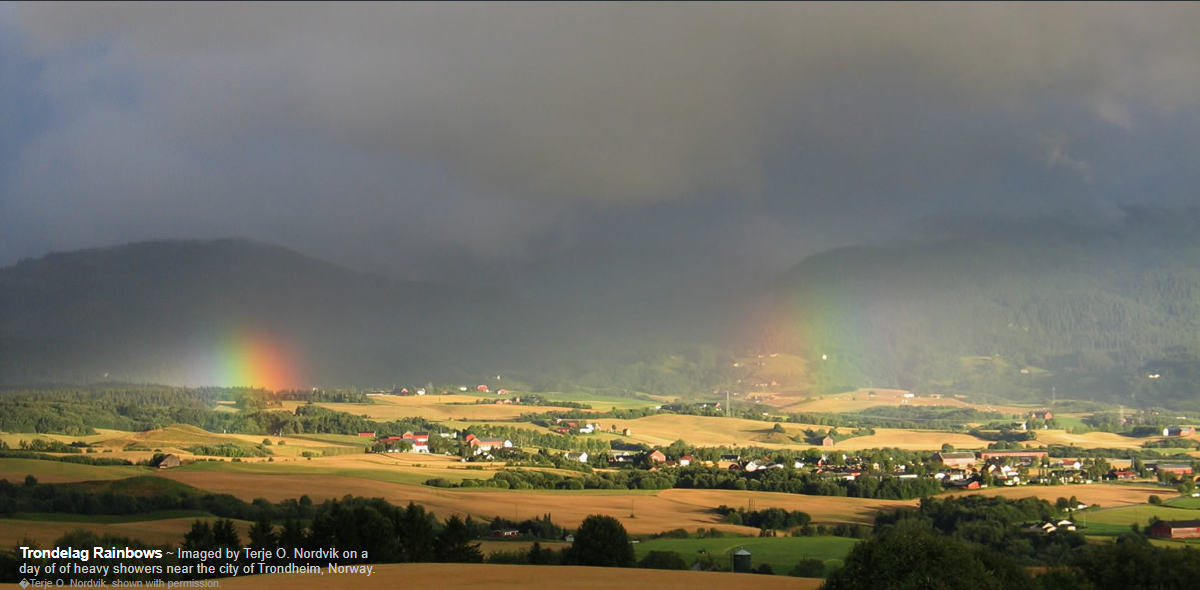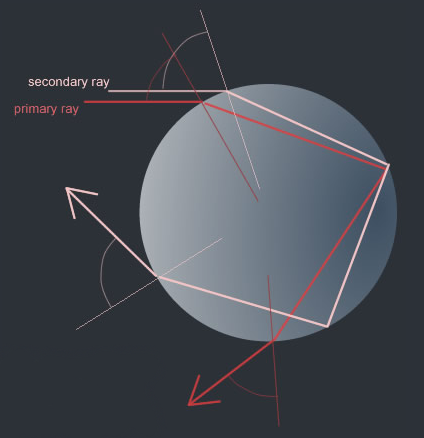Trondelag Bows
Trondelag Bows: A Mesmerizing Display of Atmospheric Optics
Have you ever witnessed a captivating display of rainbows near the city of Trondheim, Norway? Terje O. Nordvik was fortunate enough to capture the beauty of Trondelag bows on a day of heavy showers. In this article, we will delve into the fascinating world of atmospheric optics and explore the intricacies of these enchanting rainbows.
Rainbows are a result of the interaction between sunlight and raindrops in the atmosphere. The primary bow, visible on the left side of the image, is formed by a single reflection inside the raindrops. On the right side, we can observe the secondary bow, which is created by two reflections. These bows offer a mesmerizing sight with their vivid colors and unique characteristics.
The width of a rainbow is determined by the position where the rays forming the rainbow enter and exit the raindrops. The angle at which these rays hit the raindrop's surface, known as the 'angle of incidence,' plays a crucial role in determining the width of the bow. Rays entering closer to the periphery of the raindrop result in a larger incidence angle, leading to a more widely spread distribution of colors.
One intriguing aspect of Trondelag bows is the phenomenon of rainbow fragments. These occur when clouds obstruct sunlight from reaching raindrops in other parts of the rainbow cone. The rainbow cone refers to the three-dimensional zone where droplets reflect and refract sunlight, causing rainbow rays to be directed towards our eyes. As a result, we see fragmented sections of the rainbow rather than a complete arc.
To better understand Trondelag bows and their formation, let's summarize some key points:
- Rainbows are formed by the interaction between sunlight and raindrops in the atmosphere.
- The primary bow is created by a single reflection inside the raindrops, while the secondary bow results from two reflections.
- The width of the bows is influenced by the angle of incidence, which is determined by the position where the rainbow-forming rays enter and leave the raindrops.
- Trondelag bows exhibit a striking display of colors, with the secondary bow showcasing reversed colors that are more widely dispersed.
- Rainbow fragments occur when clouds prevent sunlight from reaching raindrops in other parts of the rainbow cone.
Now, let's appreciate the beauty of Trondelag bows as captured by Terje O. Nordvik. The image showcases the primary bow gracefully hugging the landscape on the left side. Meanwhile, the secondary bow on the right side captivates us with its reversed colors, spreading across a wider area. This stunning visual spectacle serves as a testament to the wonders of atmospheric optics.
In conclusion, Trondelag bows offer a breathtaking display of atmospheric optics in the vicinity of Trondheim, Norway. These rainbows, with their primary and secondary bows, showcase the magical interplay between sunlight and raindrops. The width of the bows, influenced by the angle of incidence, determines the extent to which the colors are spread. Furthermore, the occurrence of rainbow fragments adds an element of mystery and intrigue to this natural phenomenon. So, keep your eyes open during rainy days in Trondheim, as you might just be fortunate enough to witness the enchanting beauty of Trondelag bows.

Trondelag Rainbows ~ Imaged by Terje O. Nordvik on a day of of heavy showers near the city of Trondheim, Norway. �Terje O. Nordvik, shown with permission.
At left a slice of the primary bow hugs the landscape. At right is the secondary bow with its reversed colours more widely dispersed.
The primary derives from a single reflection inside the raindrops. The secondary bow is the result of two reflections.
The widths of the bows are determined by the position where the rainbow forming rays enter and leave the drops. The closer the ray to the periphery, the greater is the 'angle of incidence'' - the angle between a ray and a perpendicular from the surface. The larger the incidence angle the more widely spread are the colours.
We see rainbow fragments when clouds prevent sunlight from shining on raindrops elsewhere along the rainbow cone � the 3D zone where droplets glint rainbow rays towards your eye.

Note: this article has been automatically converted from the old site and may not appear as intended. You can find the original article here.
Reference Atmospheric Optics
If you use any of the definitions, information, or data presented on Atmospheric Optics, please copy the link or reference below to properly credit us as the reference source. Thank you!
-
<a href="https://atoptics.co.uk/blog/trondelag-bows/">Trondelag Bows</a>
-
"Trondelag Bows". Atmospheric Optics. Accessed on April 23, 2024. https://atoptics.co.uk/blog/trondelag-bows/.
-
"Trondelag Bows". Atmospheric Optics, https://atoptics.co.uk/blog/trondelag-bows/. Accessed 23 April, 2024
-
Trondelag Bows. Atmospheric Optics. Retrieved from https://atoptics.co.uk/blog/trondelag-bows/.